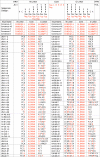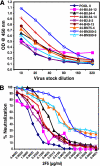Broad neutralization of human immunodeficiency virus type 1 (HIV-1) elicited from human rhinoviruses that display the HIV-1 gp41 ELDKWA epitope
- PMID: 19279101
- PMCID: PMC2682058
- DOI: 10.1128/JVI.00184-09
Broad neutralization of human immunodeficiency virus type 1 (HIV-1) elicited from human rhinoviruses that display the HIV-1 gp41 ELDKWA epitope
Abstract
In efforts to develop AIDS vaccine components, we generated combinatorial libraries of recombinant human rhinoviruses that display the well-conserved ELDKWA epitope of the membrane-proximal external region of human immunodeficiency virus type 1 (HIV-1) gp41. The broadly neutralizing human monoclonal antibody 2F5 was used to select for viruses whose ELDKWA conformations resemble those of HIV. Immunization of guinea pigs with different chimeras, some boosted with ELDKWA-based peptides, elicited antibodies capable of neutralizing HIV-1 pseudoviruses of diverse subtypes and coreceptor usages. These recombinant immunogens are the first reported that elicit broad, albeit modest, neutralization of HIV-1 using an ELDKWA-based epitope and are among the few reported that elicit broad neutralization directed against any recombinant HIV epitope, providing a critical advance in developing effective AIDS vaccine components.
Figures






References
-
- Alfsen, A., and M. Bomsel. 2002. HIV-1 gp41 envelope residues 650-685 exposed on native virus act as a lectin to bind epithelial cell galactosyl ceramide. J. Biol. Chem. 27725649-25659. - PubMed
-
- Alfsen, A., P. Iniguez, E. Bouguyon, and M. Bomsel. 2001. Secretory IgA specific for a conserved epitope on gp41 envelope glycoprotein inhibits epithelial transcytosis of HIV-1. J. Immunol. 1666257-6265. - PubMed
-
- Arnold, G. F., and E. Arnold. 1999. Using combinatorial libraries to develop vaccines. ASM News http://newsarchive.asm.org/sept99/feature2.asp.
-
- Arnold, G. F., D. A. Resnick, Y. Li, A. Zhang, A. D. Smith, S. C. Geisler, A. Jacobo-Molina, W.-M. Lee, R. G. Webster, and E. Arnold. 1994. Design and construction of rhinovirus chimeras incorporating immunogens from polio, influenza, and human immunodeficiency viruses. Virology 198703-708. - PubMed
-
- Baba, T. W., V. Liska, R. Hofmann-Lehmann, J. Vlasak, W. Xu, S. Ayehunie, L. A. Cavacini, M. R. Posner, H. Katinger, G. Stiegler, B. J. Bernacky, T. A. Rizvi, R. Schmidt, L. R. Hill, M. E. Keeling, Y. Lu, J. E. Wright, T. C. Chou, and R. M. Ruprecht. 2000. Human neutralizing monoclonal antibodies of the IgG1 subtype protect against mucosal simian-human immunodeficiency virus infection. Nat. Med. 6200-206. - PubMed
Publication types
MeSH terms
Substances
Grants and funding
LinkOut - more resources
Full Text Sources
Other Literature Sources

